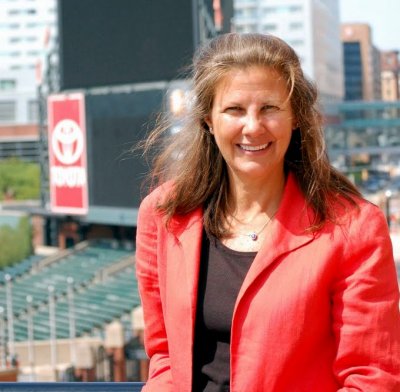
Janet Marie Smith, vice president of planning and development for the Baltimore Orioles, stands on a pedestrian bridge that connects Oriole Park to the Camden Yards Warehouse. (Photo: Steve Kilar)
This is one in a series of eight articles about the Baltimore Orioles and Camden Yards.
BALTIMORE (Sept. 7, 2010)—A weighty stack of poster-sized blueprints, several inches thick, is neatly arranged on the floor in the corner of Janet Marie Smith's office in the Camden Yards warehouse.
The office has a spectacular view, which is difficult to ignore, of the Oriole Park field. But other than the piled blueprints and nondescript office plants, the office seems a bit bare—as if Smith isn't settled in.
Smith, vice president of planning and development for the Baltimore Orioles, is not accustomed to being in one place too long. She has spent the past 15 years commuting by plane from Baltimore, living in hotels several days a week, to work with Major League Baseball teams across the country.
Now Smith is traveling at least two days a week to Sarasota, Florida, where she is overseeing the renovation of Ed Smith Stadium, the Orioles' new nest when the team migrates south for winter.
Her office hints at busy—stacked books and papers in odd spots along the baseboards, un-hung items leaning against walls. But Smith is welcoming and calm. She wears a bright pink blazer, has eyes that grin and speaks with a thoughtful Southern cadence.
Her brown hair, wispy around her face, is clipped back. She sits, relaxed, in a utilitarian office chair at a round worktable in the middle of her space.
This office on the fourth floor of the warehouse is the same one she occupied in the early 1990s, when she had the same title she holds now and was a key figure in the construction and design of Oriole Park.
Smith, who began working with the Orioles in March 1989, left that post in 1994 but returned last year.
The Orioles team, however, is not the one it was in the late '80s and early '90s. That was the team of Cal Ripken Jr., a team proud of its pennants and World Series victories, a team that sold out the ballpark for every game, year after year.
But to Smith, the current state of the Orioles—the team with the worst record in baseball for most of the 2010 season—is just a footnote.
Smith's goal, she says, is to help create facilities for the team that will serve them through "the good times and the bad."
She is optimistic the bad times will not last much longer, particularly since Buck Showalter, the man who revived the New York Yankees in the early 1990s, took over as the team's manager in early August.
And she is focused on the building she helped open in 1992.
Oriole Park, Smith said, has aged well. Plus, she adds, the crowds the iconic stadium draws on its own are still strong.
Nevertheless, Smith is always contemplating ways to improve Oriole Park.
"Stadiums have become more social over the years," Smith said, noting that private boxes, restaurants and larger open spaces are now more common.
Smith—who has three children with her husband, Bart Harvey, a non-profit executive—also recently helped redesign the children's play area at Camden Yards, a feature that was not typical in stadiums 20 years ago.
Smith was just 31 when she joined the Orioles, an urban planner with a background in architecture. She got her job by writing letters first to the Maryland Stadium Authority and then to the Orioles.
She sold herself to Larry Lucchino, who was the Orioles' president, as a planner with the vision to combine traditional urban features with innovative design—an element of the city park renovations she worked on in New York and Los Angeles during the '80s.
Lucchino hired her to be the Orioles' connection to the stadium's architects and Smith moved to Baltimore.
Nowadays it is common to see steel supports on the undersides of baseball stadiums, elegantly paying homage to architectural traditions from the Industrial Revolution while simultaneously holding up rows of molded-plastic seats.
But in the late 1980s, when the Orioles and the Maryland Stadium Authority were hashing out plans for Oriole Park at Camden Yards, concrete foundations were the norm among the doughnut-shaped stadiums built during the last half-century.
Smith thought Maryland could do better.
Not willing to settle for a concrete doughnut in downtown Baltimore, Smith scrutinized the original stadium plans and decided to get a second opinion, said Bruce Hoffman, who was the Maryland Stadium Authority's executive director from 1989 to 2000.
The problem was money. Concrete would be cheaper.
"We had to make a decision between a concrete foundation on budget or a steel one over budget," Hoffman said.
Smith brought the plans to a structural engineering firm that confirmed her impression: The foundation design was bulky and excessive.
Smith took that information to the stadium's architect, Joseph Spear of Hellmuth, Obata & Kassabaum in Kansas City, Missouri, and—through what Hoffman recalls as "excellent teamwork"—a trimmed-down steel foundation was designed that was within the Stadium Authority's budget.
The distinctive steel feature hearkens to the old-style ball yards of the early 20th Century while providing the modern comfort that fans and players want.
Herb Belgrad, the Stadium Authority's chairman during the construction of Oriole Park, said that Smith "was promoting the best interests of the Orioles, and it benefitted the design.
"There was a balance between the (Hellmuth) team and the input of the Orioles through Janet Marie Smith."
Alan Rifkin, a Baltimore lawyer who represents the Orioles and worked with Smith on stadium projects over the last two decades, said she "is single-handedly responsible for saving the historical roots of professional sports facilities. She fought hard."
"I wouldn't work on a stadium project with anyone else," Rifkin said.
Smith grew up in Mississippi and received at bachelor's degree in architecture from Mississippi State University. She went on to receive a master's degree in urban planning from City College of New York.
During graduate school, Smith was assigned Baltimore as a case study. On research visits, she developed a special interest in Baltimore's Inner Harbor revitalization plans.
"It's a real city," Smith said of Baltimore, "It's a manageable size. It has an authenticity to it."
While Smith lived in New York, she began to appreciate baseball—and baseball stadiums. She would take the subway up through Manhattan's East Side and step into the fray around Yankee Stadium.
"Each stadium is a different slice of Americana," Smith said, contrasting the feel of Yankee Stadium—which is tucked into the Bronx and most easily reached by subway—with Dodger Stadium in Anaheim, Calif., a field that is sunk into the ground and accommodates car culture.
In her first two years on the job, Smith worked out of the Orioles' offices in Memorial Stadium. Now she says it was fortunate she was not in Memorial Stadium longer, because she came to appreciate the traditions and architectural quirks of the Orioles' old city-owned home—which may have made it difficult to objectively assess Camden Yards plans.
The design team retained several idiosyncrasies of Memorial Stadium in Oriole Park.
Smith and the architects adapted Memorial's unusual field dimensions to Oriole Park and paid homage to the flag flown outside Memorial—which marked Frank Robinson's home run that rocketed out of the now-razed stadium—by installing baseball-shaped brass plaques in the pedestrian path on Eutaw Street to memorialize spectacular hits.
Smith contributed many of what Belgrad called the "refinements and the extras."
She also encouraged a design that would make Oriole Park seem "like it had been organically grown" out of the landscape of Camden Yards, Smith said.
"You couldn't pull a 1,000-foot-long by 50-foot-wide brick warehouse out of script," Smith said of the orange-brick structure that borders Oriole Park on the north and houses the Orioles management, the Maryland Stadium Authority, the Mid-Atlantic Sports Network and other tenants.
In 1994, Smith left the Orioles and went on to work for the Boston Red Sox, where she helped renovate Fenway Park, and the Atlanta Braves. She has also been a consultant on other major league stadiums, including the San Diego Padres' Petco Park.
When she heard in 2009 that the Orioles were going to update Oriole Park and renovate Ed Smith Stadium in Sarasota, Florida, to be the Orioles' new spring training home, Smith pulled an old trick out of her hat: She wrote a letter to Peter Angelos, the Orioles' owner, and told him she wanted to work for the Orioles again.
Smith believes buildings are too often demolished while they're still useful and she appreciates that, in Florida, the Orioles decided to revamp an older stadium. Updating Ed Smith Stadium maintains Sarasota's history as Oriole Park built upon historical structures in Baltimore, she added.
"It has been a great professional challenge taking a concrete stadium from the 1980s and making it feel new," Smith said.
This story was produced by the Baltimore Urban Affairs Reporting class of the Philip Merrill College of Journalism, the University of Maryland, College Park. The class is supported by the Abell Foundation, with other resources provided by The Baltimore Sun. It is distributed by the University of Maryland's Capital News Service.

